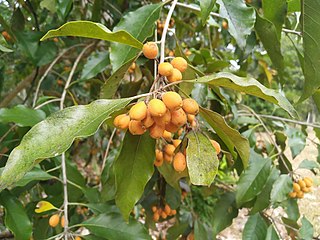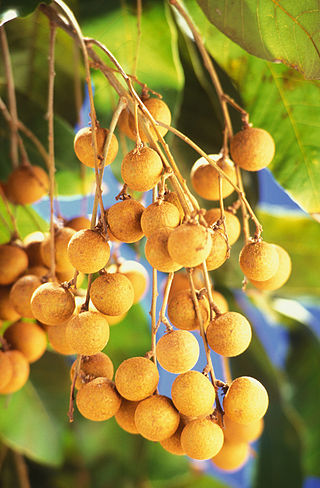
Dimocarpus is a genus of trees or shrubs in the flowering plant family Sapindaceae. It includes 7 species which grow naturally in tropical south and Southeast Asia, Malesia, Papuasia, and Australasia, including Sri Lanka, India, the Philippines, southern China, Taiwan, Myanmar, Cambodia, Vietnam, Malaysia, Indonesia, New Guinea, East Timor, far north-eastern Queensland, Australia.

Pittosporaceae is a family of flowering plants that consists of 200–240 species of trees, shrubs, and lianas in 9 genera. Habitats range from tropical to temperate climates of the Afrotropical, Indomalayan, Oceanian, and Australasian realms. The type genus is Pittosporum Banks ex Gaertn.

Pittosporum is a genus of about 200 species of flowering plants in the family Pittosporaceae. The genus is probably Gondwanan in origin; its present range extends from Australasia, Oceania, eastern Asia and some parts of Africa. Citriobatus can be included here, but might be a distinct genus. They are commonly known as pittosporums or, more ambiguously, cheesewoods.

Allocasuarina torulosa, commonly known as forest oak, rose sheoak, river oak or Baker's oak, is a species of flowering plant in the family Casuarinaceae and is endemic to eastern Australia. It is a slender, usually dioecious tree that has drooping branchlets up to 140 mm (5.5 in) long, the leaves reduced to scales in whorls of four or five, and the fruiting cones 15–33 mm (0.59–1.30 in) long containing winged seeds 7–10 mm (0.28–0.39 in) long.

Hovea is a genus of about forty species of flowering plants in the family Fabaceae, and is endemic to Australia. Plants in this genus are sub-shrubs, shrubs or small trees with simple leaves and purple, blue or mauve flowers with a white centre. The fruit is a pod containing brown to blackish seeds. Species of Hovea occur in all Australian states, the Australian Capital Territory and the Northern Territory.

Hymenosporum is a monotypic genus in the family Pittosporaceae. The sole included species is Hymenosporum flavum, commonly known as native frangipani, which is a rainforest tree native to New Guinea, Queensland and New South Wales. Despite its common name, it is not closely related to the frangipani, but is related to the widespread genus Pittosporum.

Heritiera littoralis, commonly known as the looking-glass mangrove or tulip mangrove, is a mangrove tree in the family Malvaceae native to coastal areas of eastern Africa, Asia, Melanesia and northern Australia. The common name refers to the silvery appearance of the underside of the leaves, resembling a mirror to some degree. The strong timber has uses in marine applications and elsewhere.

Auranticarpa is a genus of trees in the family Pittosporaceae. All six species occur in monsoonal forest and rainforest margins in Northern Australia. The species, all formerly included in the genus Pittosporum, are as follows:

Pittosporum multiflorum, known as the orange thorn, is a shrub growing in eastern Australia. The dense foliage provides a habitat for small birds and animals. It grows on shales or volcanic soils, from Eden, New South Wales north to Queensland, usually in or near rainforest areas.
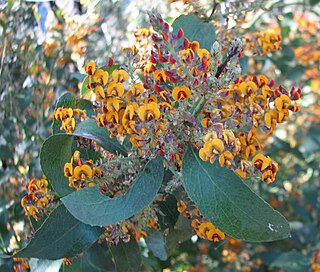
Daviesia latifolia, commonly known as hop bitter-pea, is a species of flowering plant in the family Fabaceae and is endemic to south-eastern Australia. It is a slender, erect, spreading shrub with elliptic, egg-shaped or lance-shaped phyllodes and orange-yellow and maroon flowers in long racemes.

Planchonella eerwah is a rare species of Australian rainforest tree in the family Sapotaceae. Common names include shiny-leaved condoo, black plum and wild apple. It is endemic to south eastern Queensland, with a restricted distribution and regarded as endangered.

Melaleuca decussata, commonly known as cross-leaf honey-myrtle or totem poles, is a plant in the myrtle family, Myrtaceae native to South Australia and both native and naturalised in Victoria. It is an adaptable shrub, grown in many parts of Australia for its attractive foliage but is regarded as an environmental weed in parts of Victoria.

Pittosporum angustifolium is a shrub or small tree growing throughout inland Australia. Common names include weeping pittosporum, butterbush, cattle bush, native apricot, apricot tree, gumbi gumbi, cumby cumby, meemeei, poison berry bush, and berrigan.

Lotus glaucus is a species of flowering plant in the family Fabaceae, native to Madeira and the Salvage Islands. It is a perennial herbaceous plant with leaves made up of five leaflets. Its flowers are usually orange on opening. Lotus tenellus is included in a more broadly circumscribed L. glaucus by some authors, which extends its distribution to the Canary Islands.

Bossiaea linophylla is a species of flowering plant in the family Fabaceae and is endemic to the south-west of Western Australia. It is a spreading shrub with linear to oblong or egg-shaped leaves, and bright yellow to orange or apricot-coloured and red flowers.

Daviesia mimosoides, commonly known as blunt-leaf bitter-pea, narrow-leaf bitter pea or leafy bitter-pea, is a species of flowering plant in the family Fabaceae and is endemic to eastern continental Australia. It is an open shrub with tapering, linear, elliptic or egg-shaped phyllodes, and groups of orange-yellow and dark brownish-red to maroon flowers.

Hovea longifolia commonly known as rusty pods, is a flowering plant in the family Fabaceae, endemic to eastern Australia. It has purple pea flowers, linear leaves with rusty felt like hairs on the lower surface.
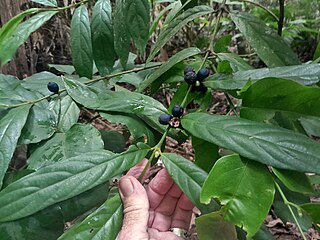
Lasianthus chlorocarpus, commonly known as blue rubi, is a plant in the family Rubiaceae native to parts of Malesia, Papuasia and Australia. It is an evergreen shrub growing up to 2 m high in well developed rainforest.
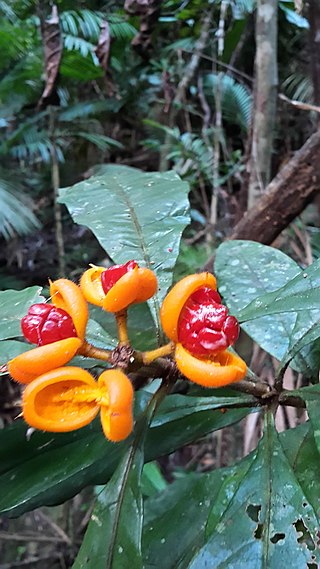
Pittosporum rubiginosum, commonly known as hairy red pittosporum, is an evergreen shrub in the family Pittosporaceae which is endemic to northeastern Queensland, Australia.




